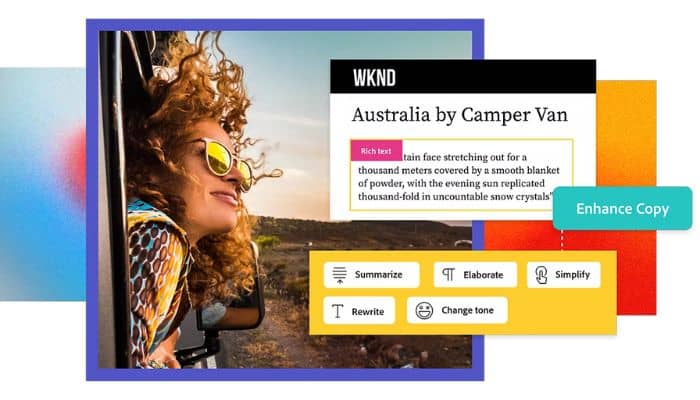Singapore – Ahead of the 2023 NAB Show – the conference and exhibition for broadcast, media, and entertainment – Adobe announced several new innovations across its family of video applications, including AI-powered text-based video editing and automated color tone-mapping capabilities in Premiere Pro. In addition, significant GPU acceleration and dozens of workflow enhancements make this the fastest version of Premiere Pro ever released.
The company said its latest innovations are designed to address the workflow needs of today’s professional editors and motion designers by automating time-intensive tasks, freeing creative professionals to spend more time “shaping the stories they want to tell.” Adobe also announced new innovations and partnerships that expand Frame.io, its video collaboration platform, with more features for photography and PDF documents.
Moreover, Adobe is celebrating 30 years of After Effects, its popular motion design software for video professionals, adding a context-sensitive Properties Panel for enhanced user productivity, consistent color support as well as performance optimizations.
“Today’s video professionals are racing to meet insatiable demand for standout content across platforms and surfaces,” said Ashley Still, senior vice president of Creative Product Group and Digital Media Growth at Adobe. “We are excited to advance workflows and inspire new creative expression with the latest cutting-edge Premiere Pro and After Effects innovations, empowering creative professionals to focus on the craft of creating, while cutting out time-consuming tasks that prolong content ideation, creation and delivery.”
Leveraging Adobe Sensei, Adobe’s machine learning and AI framework, Premiere Pro and After Effects now streamline video workflows and offer AI-powered editing that saves production teams hours and significantly reduces costs.
Key updates to Premiere Pro include:
- Text-Based Editing represents a shift in post-production workflows. Premiere Pro is the only professional editing software to incorporate Text-Based Editing, revolutionizing the way creators approach their craft by making video editing as simple as copying and pasting text. Powered by Adobe Sensei, Text-Based-Editing automatically analyses and transcribes clips so editors, producers, and assistants can simply copy and paste sentences into any order they want and instantly see them appear on the timeline. Transcripts can be searched in the transcript window to identify exact words and phrases.
- Automatic Tone Mapping and Log Color Detection lets editors mix and match HDR footage from different sources into the same SDR project and get great-looking, consistent colour. This means editors don’t need to use look-up tables (LUTs) or manually balance footage to get great-looking images.
- Premiere Pro features significant under-the-hood improvements, and is the fastest version ever shipped. In addition to enhanced performance, new features include background auto save, system reset options and anEffects Manager for plug-ins. GPU acceleration for AVC Intra and professional formats such as ARRI RAW, RED RAW, and Sony Venice V2, coupled with GPU-accelerated video scopes, transitions, and title templates, make the editing experience lightning fast and responsive so editors can now work with 8K footage in the timeline.
- Collaborative editing enhancements include Sequence Locking, enabling the active editors to lock a sequence so it becomes view-only for other editors, Presence Indicators to provide visibility on who is working on shared projects, and Work While Offline to allow editors to continue to work offline, then publish changes without overwriting others’ work when they return online. Included with Creative Cloud, Frame.io support enables secure sharing, collaborative review and project management for Premiere Pro edits, including direct export, upload and Share for Review capabilities.
- Premiere Pro also adds improved format support for RED V-Raptor X, ARRI Alexa 35 and Sony Venice v2 cameras; expanded Speech to Text support for Dutch, Norwegian, Swedish and Danish; GPU acceleration for debayering and transition effects; simpler track targeting; and the ability to export and render directly to Adobe Media Encoder.
New innovations in After Effects include:
- The new Properties Panel offers quick and easy access to the most important animation settings in one convenient panel. The Properties Panel is context-sensitive, automatically showing users the most important controls needed based on selections, cutting down on the time needed to navigate through the timeline and reducing the learning curve for new users.
- New ACES and OpenColorIO maintain consistent colors when sharing assets with other post-production apps to help users create more predictable and photo-realistic images in less time and with less effort.
- Additional new features deliver performance optimizations including faster timeline layer selection and multi-frame rendering of shapes – plus new keyboard shortcuts for Selectable Track Mattes. After Effects now helps users fix common issues without the need for IT expert assistance, including in-app troubleshooting for potential workflow issues, system performance optimizations, simple interfaces for enabling and disabling plug-ins and diagnostics to fix bottlenecks in caches and preferences.
To empower partners to deliver creative experiences that inspire, transform and move the world forward, Adobe is launching a new Adobe Video Partner Program that provides a holistic, end-to-end approach across all Adobe video tools. The program offers access to exclusive benefits, resources and solutions designed to help grow and develop our partners’ businesses as they evolve.
Over 400 global partners are now delivering solutions for Adobe customers, including chipmakers AMD, Intel and Nvidia; camera makers Canon, Nikon, RED and Sony; and technology providers ranging from AWS to Fraunhofer IIS and Microsoft. Newly announced integrations with FUJIFILM expand Adobe’s leading collaborative video review and approval platform Frame.io to support end-to-end workflows for capturing, editing, reviewing and approving photos.
Adobe’s latest releases of Premiere Pro and After Effects, including beta versions of Premiere Pro’s Text-Based Editing and Automatic Tone Mapping, and After Effects’ Properties Panel, will be on display at the 2023 NAB Show from April 15-19 in Las Vegas and generally available in May 2023.









